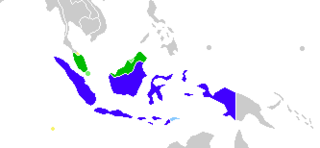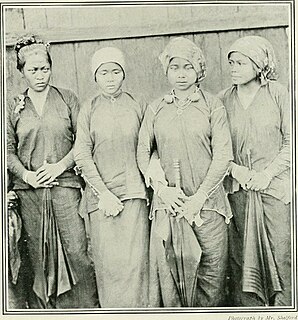
Mumong is a residential suburb of Kuala Belait, the principal town of Belait District, Brunei. It comprises the original Mumong settlement, as well as the Mumong public housing estate of the Landless Indigenous Citizens' Housing Scheme. However, it officially consists of two village subdivisions, namely Mumong 'A' and Mumong 'B', which are under the mukim of Kuala Belait.
Liang is a mukim or subdistrict of Belait, a district of Brunei. Liang is headed by a penghulu and the incumbent is Abdul Hamid bin Mumin.

Lumut, also known as Kampong Lumut, is a settlement area in Belait District, Brunei. It is the common name given to a group of village subdivisions and residential communities in the subdistrict of Liang.

Bukit Beruang is a populated place in Tutong District, Brunei. It is officially a village subdivision under Telisai, a mukim (subdistrict) in the district. Bukit Beruang is primarily a public housing estate of the National Housing Scheme, a government housing programme.

Mentiri National Housing Scheme is a public housing estate in Brunei-Muara District, Brunei. It is one of the housing estates under the government programme National Housing Scheme which provides housing opportunities for the Bruneian citizens. Mentiri National Housing Scheme is located adjacent to Mentiri, the settlement in which it is named after.

Katok 'A', officially Katok 'A' Landless Indigenous Citizens' Housing Scheme, also Area 3 of Tungku Landless Indigenous Citizens' Housing Scheme, is a village administrative division in Brunei-Muara District of Brunei. It is a village subdivision under the mukim or subdistrict of Gadong 'A'. Katok 'A' has an area of 69.15 hectares and, as of 2014, the population is 1,776. The community of Katok 'A' is headed by a ketua kampung or village head and the incumbent is Adanan bin Bagol. Katok 'A' is also a designated postcode area with the postcode BE2919.

Mata-Mata, locally known in Malay as Kampung Mata-Mata or Kampong Mata-Mata, is a populated place in Brunei-Muara District, Brunei. It is a group of settlements on the outskirts of Bandar Seri Begawan, the capital of Brunei, comprising the original settlement of Mata-Mata, the Perpindahan Mata-Mata settlement and the Mata-Mata public housing areas of the Landless Indigenous Citizens' Housing Scheme.

Katok, locally known in Malay as Kampung Katok or Kampong Katok, is a village administrative division in Brunei-Muara District, Brunei. It is a village subdivision under the mukim or subdistrict of Gadong 'A'. The community of Katok is jointly led with that of Tungku subdivision by a ketua kampung or village head, and the incumbent is Ismail bin Rajab. Katok is also a designated postcode area with the postcode BE2319.

Pancha Delima is a small residential neighbourhood in Bandar Seri Begawan, the capital of Brunei. It is officially a village subdivision under Berakas A, a mukim (subdistrict) of Brunei-Muara District; the incumbent ketua kampung or village head is Zulkifli bin Awang Ya'akub. The postcode for Pancha Delima is BB4513.

Orang Kaya Besar Imas is a small residential neighbourhood in Bandar Seri Begawan, the capital of Brunei. It is officially a village subdivision under Berakas A, a mukim (subdistrict) of Brunei-Muara District. The postcode for Orang Kaya Besar Imas is BB4113.

Katok 'B', also known as Mata-Mata Landless Indigenous Citizens' Housing Scheme or the abbreviated Malay name STKRJ Mata-Mata, is a public housing estate on the outskirts of Bandar Seri Begawan in Brunei-Muara District, Brunei. It is officially designated as three villages, the third- and lowest-level subdivisions of Brunei. Katok 'B' is one of the estates in the country under the Landless Indigenous Citizens' Housing Scheme, a public housing programme.

Perpindahan Mata-Mata is a settlement on the outskirts of Bandar Seri Begawan, the capital of Brunei. It is officially a village subdivision under Gadong 'B', a mukim (subdistrict) of Brunei-Muara. Perpindahan Mata-Mata comprises the public housing estate under the National Resettlement Programme, as well as the original Landless Indigenous Citizens' Housing Scheme estate of Mata-Mata. The postcode for Perpindahan Mata-Mata is BE1918.

Bunut Perpindahan is a neighbourhood in Bandar Seri Begawan, the capital of Brunei. It is officially a village subdivision under Kilanas, a mukim (subdistrict) of Brunei-Muara District.

Lambak Kiri Landless Indigenous Citizens' Housing Scheme is a public housing estate in Lambak Kiri, a populated place in Brunei-Muara District, Brunei. It is officially a village subdivision of Berakas A. Lambak Kiri Landless Indigenous Citizens' Housing Scheme is one of the housing estates in the country for the Landless Indigenous Citizens' Housing Scheme which is a government housing programme for the rakyat jati or indigenous citizens of Brunei.

Pengiran Siraja Muda Delima Satu, commonly known as Delima Satu or Pengiran Siraja Muda, is a neighbourhood in Bandar Seri Begawan, the capital of Brunei. It is also a village subdivision under Berakas A, a mukim (subdistrict) in Brunei-Muara District. Pengiran Siraja Muda Delima Satu is primarily a residential area but also contains the commercial area of Delima, one of the commercial areas in the capital. The postcode for Pengiran Siraja Muda Delima Satu is BB5113.

Rimba National Housing Scheme is a public housing estate on the northern outskirts of Bandar Seri Begawan, the capital of Brunei. It officially consists of five village subdivisions which are under Gadong 'A', a mukim (subdistrict) in Brunei-Muara District. Rimba National Housing Scheme is one of the housing estates under the National Housing Scheme, a government housing programme for the citizens of Brunei. It is de facto a suburb of the capital.

Rimba Landless Indigenous Citizens' Housing Scheme is a public housing estate near Rimba on the outskirts of Bandar Seri Begawan, the capital of Brunei. It is officially a village under Gadong 'A', a mukim (subdistrict) of Brunei-Muara District. As a village, it has an area of 69.15 hectares and the population of 6,800. Rimba Landless Indigenous Citizens' Housing Scheme is one of the public housing estates in the country under its namesake, which is a government housing programme for the rakyat jati or indigenous citizens of Brunei.

Sungai Buloh is a settlement in Brunei-Muara District, Brunei. It is officially a village-level subdivision in Mentiri, a mukim (subdistrict) in the district. Sungai Buloh comprises the original Sungai Buloh village settlement, as well as Sungai Buloh Rakyat Jati Housing, a public housing estate under the Landless Indigenous Citizens' Housing Scheme. The postcode for Sungai Buloh is BU1229.










